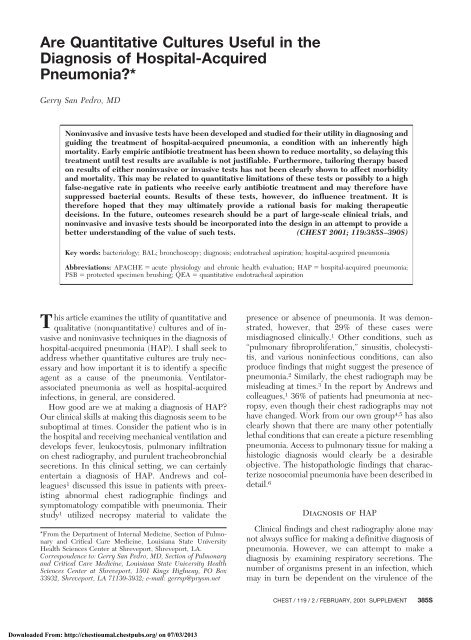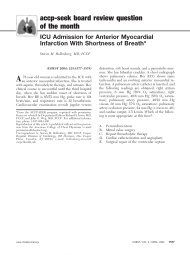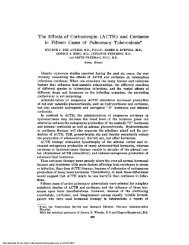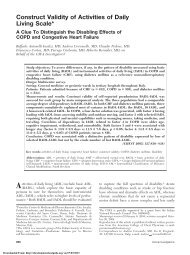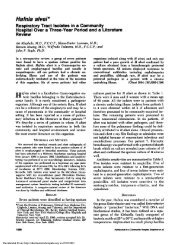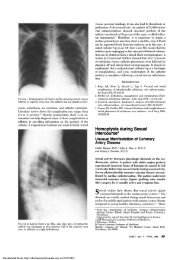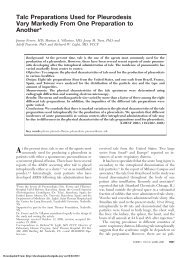Are Quantitative Cultures Useful in the Diagnosis of Hospital ...
Are Quantitative Cultures Useful in the Diagnosis of Hospital ...
Are Quantitative Cultures Useful in the Diagnosis of Hospital ...
Create successful ePaper yourself
Turn your PDF publications into a flip-book with our unique Google optimized e-Paper software.
<strong>Are</strong> <strong>Quantitative</strong> <strong>Cultures</strong> <strong>Useful</strong> <strong>in</strong> <strong>the</strong><br />
<strong>Diagnosis</strong> <strong>of</strong> <strong>Hospital</strong>-Acquired<br />
Pneumonia?*<br />
Gerry San Pedro, MD<br />
Non<strong>in</strong>vasive and <strong>in</strong>vasive tests have been developed and studied for <strong>the</strong>ir utility <strong>in</strong> diagnos<strong>in</strong>g and<br />
guid<strong>in</strong>g <strong>the</strong> treatment <strong>of</strong> hospital-acquired pneumonia, a condition with an <strong>in</strong>herently high<br />
mortality. Early empiric antibiotic treatment has been shown to reduce mortality, so delay<strong>in</strong>g this<br />
treatment until test results are available is not justifiable. Fur<strong>the</strong>rmore, tailor<strong>in</strong>g <strong>the</strong>rapy based<br />
on results <strong>of</strong> ei<strong>the</strong>r non<strong>in</strong>vasive or <strong>in</strong>vasive tests has not been clearly shown to affect morbidity<br />
and mortality. This may be related to quantitative limitations <strong>of</strong> <strong>the</strong>se tests or possibly to a high<br />
false-negative rate <strong>in</strong> patients who receive early antibiotic treatment and may <strong>the</strong>refore have<br />
suppressed bacterial counts. Results <strong>of</strong> <strong>the</strong>se tests, however, do <strong>in</strong>fluence treatment. It is<br />
<strong>the</strong>refore hoped that <strong>the</strong>y may ultimately provide a rational basis for mak<strong>in</strong>g <strong>the</strong>rapeutic<br />
decisions. In <strong>the</strong> future, outcomes research should be a part <strong>of</strong> large-scale cl<strong>in</strong>ical trials, and<br />
non<strong>in</strong>vasive and <strong>in</strong>vasive tests should be <strong>in</strong>corporated <strong>in</strong>to <strong>the</strong> design <strong>in</strong> an attempt to provide a<br />
better understand<strong>in</strong>g <strong>of</strong> <strong>the</strong> value <strong>of</strong> such tests. (CHEST 2001; 119:385S–390S)<br />
Key words: bacteriology; BAL; bronchoscopy; diagnosis; endotracheal aspiration; hospital-acquired pneumonia<br />
Abbreviations: APACHE acute physiology and chronic health evaluation; HAP hospital-acquired pneumonia;<br />
PSB protected specimen brush<strong>in</strong>g; QEA quantitative endotracheal aspiration<br />
This article exam<strong>in</strong>es <strong>the</strong> utility <strong>of</strong> quantitative and<br />
qualitative (nonquantitative) cultures and <strong>of</strong> <strong>in</strong>vasive<br />
and non<strong>in</strong>vasive techniques <strong>in</strong> <strong>the</strong> diagnosis <strong>of</strong><br />
hospital-acquired pneumonia (HAP). I shall seek to<br />
address whe<strong>the</strong>r quantitative cultures are truly necessary<br />
and how important it is to identify a specific<br />
agent as a cause <strong>of</strong> <strong>the</strong> pneumonia. Ventilatorassociated<br />
pneumonia as well as hospital-acquired<br />
<strong>in</strong>fections, <strong>in</strong> general, are considered.<br />
How good are we at mak<strong>in</strong>g a diagnosis <strong>of</strong> HAP?<br />
Our cl<strong>in</strong>ical skills at mak<strong>in</strong>g this diagnosis seem to be<br />
suboptimal at times. Consider <strong>the</strong> patient who is <strong>in</strong><br />
<strong>the</strong> hospital and receiv<strong>in</strong>g mechanical ventilation and<br />
develops fever, leukocytosis, pulmonary <strong>in</strong>filtration<br />
on chest radiography, and purulent tracheobronchial<br />
secretions. In this cl<strong>in</strong>ical sett<strong>in</strong>g, we can certa<strong>in</strong>ly<br />
enterta<strong>in</strong> a diagnosis <strong>of</strong> HAP. Andrews and colleagues1<br />
discussed this issue <strong>in</strong> patients with preexist<strong>in</strong>g<br />
abnormal chest radiographic f<strong>in</strong>d<strong>in</strong>gs and<br />
symptomatology compatible with pneumonia. Their<br />
study1 utilized necropsy material to validate <strong>the</strong><br />
*From <strong>the</strong> Department <strong>of</strong> Internal Medic<strong>in</strong>e, Section <strong>of</strong> Pulmonary<br />
and Critical Care Medic<strong>in</strong>e, Louisiana State University<br />
Health Sciences Center at Shreveport, Shreveport, LA.<br />
Correspondence to: Gerry San Pedro, MD, Section <strong>of</strong> Pulmonary<br />
and Critical Care Medic<strong>in</strong>e, Louisiana State University Health<br />
Sciences Center at Shreveport, 1501 K<strong>in</strong>gs Highway, PO Box<br />
33932, Shreveport, LA 71130-3932; e-mail: gerrsp@prysm.net<br />
Downloaded From: http://chestioumal.chestpubs.org/ on 07/03/2013<br />
presence or absence <strong>of</strong> pneumonia. It was demonstrated,<br />
however, that 29% <strong>of</strong> <strong>the</strong>se cases were<br />
misdiagnosed cl<strong>in</strong>ically. 1 O<strong>the</strong>r conditions, such as<br />
“pulmonary fibroproliferation,” s<strong>in</strong>usitis, cholecystitis,<br />
and various non<strong>in</strong>fectious conditions, can also<br />
produce f<strong>in</strong>d<strong>in</strong>gs that might suggest <strong>the</strong> presence <strong>of</strong><br />
pneumonia. 2 Similarly, <strong>the</strong> chest radiograph may be<br />
mislead<strong>in</strong>g at times. 3 In <strong>the</strong> report by Andrews and<br />
colleagues, 1 36% <strong>of</strong> patients had pneumonia at necropsy,<br />
even though <strong>the</strong>ir chest radiographs may not<br />
have changed. Work from our own group 4,5 has also<br />
clearly shown that <strong>the</strong>re are many o<strong>the</strong>r potentially<br />
lethal conditions that can create a picture resembl<strong>in</strong>g<br />
pneumonia. Access to pulmonary tissue for mak<strong>in</strong>g a<br />
histologic diagnosis would clearly be a desirable<br />
objective. The histopathologic f<strong>in</strong>d<strong>in</strong>gs that characterize<br />
nosocomial pneumonia have been described <strong>in</strong><br />
detail. 6<br />
<strong>Diagnosis</strong> <strong>of</strong> HAP<br />
Cl<strong>in</strong>ical f<strong>in</strong>d<strong>in</strong>gs and chest radiography alone may<br />
not always suffice for mak<strong>in</strong>g a def<strong>in</strong>itive diagnosis <strong>of</strong><br />
pneumonia. However, we can attempt to make a<br />
diagnosis by exam<strong>in</strong><strong>in</strong>g respiratory secretions. The<br />
number <strong>of</strong> organisms present <strong>in</strong> an <strong>in</strong>fection, which<br />
may <strong>in</strong> turn be dependent on <strong>the</strong> virulence <strong>of</strong> <strong>the</strong><br />
CHEST / 119 /2/FEBRUARY, 2001 SUPPLEMENT 385S
organism and <strong>the</strong> host’s response, is <strong>of</strong> prime importance.<br />
How many organisms must be detected to<br />
assume <strong>the</strong> presence <strong>of</strong> <strong>in</strong>fection vs mere colonization?<br />
Johanson and colleagues 7 have suggested that<br />
about 10 3 cfu/g <strong>of</strong> tissue <strong>in</strong>dicate <strong>the</strong> presence <strong>of</strong><br />
<strong>in</strong>fection, although this could depend on <strong>the</strong> type <strong>of</strong><br />
bacteria present. Tissue is <strong>of</strong>ten not available, however,<br />
and counts may have to be obta<strong>in</strong>ed <strong>in</strong> secretions.<br />
In this case, about 10 5 bacteria per milliliter<br />
<strong>of</strong> exudate may have similar import. 8 Sources <strong>of</strong><br />
sampl<strong>in</strong>g for mak<strong>in</strong>g a diagnosis <strong>in</strong>clude blood and<br />
o<strong>the</strong>r body fluids as well as several techniques<br />
available for obta<strong>in</strong><strong>in</strong>g samples. These techniques<br />
<strong>in</strong>clude needle aspiration, endotracheal aspiration,<br />
and both bl<strong>in</strong>d and <strong>in</strong>vasive procedures to obta<strong>in</strong><br />
bronchial secretions (Table 1).<br />
Percutaneous Needle Aspiration<br />
How useful <strong>in</strong> general is percutaneous needle<br />
aspiration? As noted above, much depends on <strong>the</strong><br />
bacterial counts <strong>in</strong> <strong>the</strong> area be<strong>in</strong>g aspirated. 9 The<br />
sensitivity <strong>of</strong> <strong>the</strong> technique for patients who are not<br />
receiv<strong>in</strong>g mechanical ventilation is about 60%, 10 with<br />
<strong>the</strong> figure somewhat lower (approximately 40%) for<br />
patients receiv<strong>in</strong>g mechanical ventilation. 11 Thus,<br />
<strong>the</strong> procedure may prove to be less useful <strong>in</strong> <strong>the</strong><br />
population <strong>of</strong> patients <strong>in</strong> which it is most needed.<br />
From <strong>the</strong> standpo<strong>in</strong>t <strong>of</strong> predictive value, a positive<br />
test result is helpful, but a negative test result may<br />
not be helpful s<strong>in</strong>ce about a third <strong>of</strong> patients with a<br />
negative test result may actually have <strong>the</strong> disease. 10<br />
The ma<strong>in</strong> objection to percutaneous needle aspiration<br />
is <strong>the</strong> high <strong>in</strong>cidence <strong>of</strong> complications, <strong>in</strong>clud<strong>in</strong>g<br />
hemorrhage, hemoptysis, and pneumothorax. This is<br />
true even though <strong>the</strong> procedure itself may be fairly<br />
easy to carry out. The <strong>in</strong>cidence <strong>of</strong> pneumothorax is<br />
about 20%, but may be up to 60% <strong>in</strong> patients<br />
receiv<strong>in</strong>g mechanical ventilation. 12 About half <strong>of</strong><br />
<strong>the</strong>se patients will require a chest tube.<br />
Endotracheal Aspiration<br />
Results <strong>of</strong> endotracheal aspiration may be compared<br />
with those <strong>of</strong> o<strong>the</strong>r <strong>in</strong>vasive and non<strong>in</strong>vasive<br />
Table 1—Diagnostic Techniques<br />
Blood, Pleural Fluid Analysis, and <strong>Cultures</strong><br />
Nonbronchoscopic evaluations<br />
● Percutaneous needle aspiration<br />
● Endotracheal aspiration<br />
● Bl<strong>in</strong>d bronchial sampl<strong>in</strong>g<br />
Bronchoscopic techniques<br />
● PSB<br />
● BAL<br />
Tissue diagnosis<br />
techniques (Table 2), <strong>in</strong>clud<strong>in</strong>g open-lung biopsy,<br />
postmortem lung cultures, blood and pleural fluid<br />
analysis, and protected specimen brush<strong>in</strong>g (PSB)<br />
and BAL. 13 Sensitivity and specificity <strong>of</strong> rout<strong>in</strong>e<br />
endotracheal aspiration have a broad scatter <strong>in</strong> relation<br />
to <strong>the</strong>se o<strong>the</strong>r measurements, with sensitivity<br />
rang<strong>in</strong>g from 57 to 88%, but with specificity <strong>in</strong> a<br />
relatively low range, from 0 to 33%. Thus, nonquantitative<br />
endotracheal cultures may have limited utility.<br />
One <strong>of</strong> <strong>the</strong> chief values <strong>of</strong> endotracheal cultures<br />
is that <strong>the</strong>y exclude certa<strong>in</strong> types <strong>of</strong> <strong>in</strong>fection when<br />
<strong>the</strong> organism is absent. For example, absence <strong>of</strong><br />
Pseudomonas <strong>in</strong> an endotracheal aspirate makes it<br />
unlikely that this organism is <strong>the</strong> cause <strong>of</strong> an <strong>in</strong>fection.<br />
Attempts have also been made to perform<br />
quantitative endotracheal aspiration (QEA). Jourda<strong>in</strong><br />
and colleagues 14 have attempted to establish a<br />
cut<strong>of</strong>f for assign<strong>in</strong>g significance to colony counts <strong>in</strong><br />
endotracheal aspirates by exam<strong>in</strong><strong>in</strong>g sensitivity, specificity,<br />
and overall accuracy (Table 3). They concluded<br />
that a level <strong>of</strong> 10 5 to 10 6 bacteria per milliliter<br />
<strong>of</strong> exudate was optimal for diagnostic purposes.<br />
Although counts higher than this figure improved<br />
specificity, <strong>the</strong>re was an unacceptable decl<strong>in</strong>e <strong>in</strong><br />
sensitivity.<br />
Non<strong>in</strong>vasive Techniques<br />
Can non<strong>in</strong>vasive techniques that can be conducted<br />
at <strong>the</strong> bedside be used to obta<strong>in</strong> bronchial samples?<br />
We can employ bl<strong>in</strong>d bronchial sampl<strong>in</strong>g, 15 bl<strong>in</strong>d<br />
BAL fluid sampl<strong>in</strong>g, 16 or bl<strong>in</strong>d performance <strong>of</strong><br />
PSB. 17 We know somewhat more about <strong>the</strong> sensitivity<br />
and specificity <strong>of</strong> <strong>the</strong>se techniques. For bl<strong>in</strong>d<br />
bronchial sampl<strong>in</strong>g, <strong>the</strong> sensitivity is about 80%; for<br />
bl<strong>in</strong>d BAL, <strong>the</strong> sensitivity is about 73% with a<br />
specificity <strong>of</strong> 96%. The figures are also good for bl<strong>in</strong>d<br />
PSB, at 66% and 91%, respectively, and with a high<br />
diagnostic yield (66%) and good concordance with<br />
bronch<strong>of</strong>ibroscopic PSB (85%). 17 Then why not use<br />
<strong>the</strong>se techniques rout<strong>in</strong>ely? Unfortunately, <strong>the</strong>y are<br />
relatively new, and experience with <strong>the</strong>ir use is<br />
limited. These procedures, however, may have considerable<br />
utility <strong>in</strong> <strong>the</strong> future s<strong>in</strong>ce <strong>the</strong>y are easy to<br />
perform; <strong>in</strong> some centers, <strong>the</strong> specimens are even<br />
obta<strong>in</strong>ed by respiratory technicians.<br />
PSB<br />
PSB is a standard <strong>in</strong>vasive method for diagnos<strong>in</strong>g<br />
HAP. The brush is small and obta<strong>in</strong>s a sample <strong>in</strong> <strong>the</strong><br />
range <strong>of</strong> 0.001 mL. After <strong>the</strong> sample is obta<strong>in</strong>ed, it is<br />
diluted <strong>in</strong> about 1 mL <strong>of</strong> transport medium, an<br />
approximately 1,000-fold dilution. 18 Consequently,<br />
386S <strong>Hospital</strong>-Acquired Infections: Realities <strong>of</strong> Risks and Resistance<br />
Downloaded From: http://chestioumal.chestpubs.org/ on 07/03/2013
<strong>the</strong> standards for colony counts must be appropriately<br />
adjusted, and counts <strong>of</strong> 10 3 cfu/mL <strong>of</strong> transport<br />
medium would be considered diagnostic. Overall,<br />
this technique has about 82% sensitivity and 89%<br />
specificity. 19 However, <strong>the</strong> repeatability <strong>of</strong> this procedure<br />
<strong>in</strong> <strong>the</strong> same patient is not perfect, and<br />
quantitative discordance may be considerable. 20,21<br />
Ano<strong>the</strong>r problem with this technique and o<strong>the</strong>rs<br />
already discussed is that colony counts fall <strong>in</strong> patients<br />
previously treated with antibiotics. 22,23 The <strong>in</strong>cidence<br />
<strong>of</strong> such treatment is high, and most patients<br />
enter<strong>in</strong>g <strong>the</strong> <strong>in</strong>tensive-care environment are already<br />
be<strong>in</strong>g treated with one or more antibiotics. However,<br />
PSB could play a role <strong>in</strong> identify<strong>in</strong>g patients with<br />
recurrent or resistant <strong>in</strong>fection. In a study by Montravers<br />
and colleagues, 24 76 patients with positive<br />
specimen f<strong>in</strong>d<strong>in</strong>gs who were treated with antibiotics<br />
were restudied 3 days later. Of 173 organisms orig<strong>in</strong>ally<br />
identified, 11 organisms (6%) were shown to<br />
be still present, 3 <strong>of</strong> which were <strong>in</strong> significant<br />
numbers. However, 32 new organisms were also<br />
identified, 9 <strong>of</strong> which were <strong>in</strong> significant numbers.<br />
Resistance was observed <strong>in</strong> 26 <strong>of</strong> <strong>the</strong>se 32 organisms<br />
(81%). Thus, a total <strong>of</strong> 12 old or new organisms were<br />
noted to be present <strong>in</strong> significant numbers, and resistance<br />
did appear to represent a problem. Of <strong>the</strong> 9<br />
patients with significant numbers <strong>of</strong> new organisms,<br />
only 44% subsequently responded to treatment; however,<br />
<strong>in</strong> <strong>the</strong> o<strong>the</strong>r 67 patients, <strong>the</strong> response was 93%, a<br />
highly significant difference. Thus, perhaps <strong>the</strong>re may<br />
be a role for repeat<strong>in</strong>g PSB <strong>in</strong> <strong>the</strong> sett<strong>in</strong>g <strong>of</strong> poorly<br />
respond<strong>in</strong>g patients. However, fur<strong>the</strong>r studies need to<br />
Table 3—Value <strong>of</strong> Endotracheal Aspirates With<br />
<strong>Quantitative</strong> <strong>Cultures</strong>*<br />
Threshold,<br />
cfu/mL<br />
Sensitivity,<br />
%<br />
Table 2—Value <strong>of</strong> Endotracheal Aspirates With Rout<strong>in</strong>e <strong>Cultures</strong>*<br />
Source No. Sensitivity, % Specificity, % Reference<br />
Hill et al34 48 82 27 Open-lung biopsy, blood, pleural fluid<br />
Berger and Arango35 19 74 Postmortem lung<br />
Villers et al36 17 88 0 Blood, pleural fluid, open-lung biopsy, serology<br />
Torres et al27 41 57 14 PSB, BAL<br />
Lambert et al37 *Adapted from Meduri.<br />
22 88 33 PSB<br />
13<br />
Specificity,<br />
%<br />
Overall<br />
Accuracy,<br />
%<br />
10 3<br />
86 52 61<br />
10 4<br />
71 57 61<br />
10 5<br />
71 88 75<br />
10 6<br />
71 86 82<br />
10 7<br />
43 95 82<br />
*Adapted from Jourda<strong>in</strong> et al. 14<br />
Downloaded From: http://chestioumal.chestpubs.org/ on 07/03/2013<br />
document that repeat<strong>in</strong>g PSB <strong>in</strong> <strong>the</strong>se patients results<br />
<strong>in</strong> changes <strong>in</strong> management that lead to improved<br />
outcomes.<br />
BAL<br />
How effective is BAL as a diagnostic tool? This<br />
technique samples a large number (approximately<br />
10 6 ) <strong>of</strong> alveoli and can recover a larger number <strong>of</strong><br />
organisms. The threshold is <strong>in</strong> <strong>the</strong> range <strong>of</strong> 10 4<br />
organisms per milliliter <strong>of</strong> lavage fluid, which is<br />
equivalent to 10 6 organisms per milliliter <strong>of</strong> alveolar<br />
fluid from <strong>the</strong> periphery. 25 Sensitivity and specificity<br />
are high, <strong>in</strong> <strong>the</strong> range <strong>of</strong> 72 to 100% for sensitivity<br />
and 69 to 100% for specificity. 13 Qualitatively, <strong>the</strong><br />
same organisms are recovered repeatedly <strong>in</strong> <strong>the</strong><br />
range <strong>of</strong> 95%, but as <strong>in</strong> <strong>the</strong> case with PSB, <strong>the</strong>re is<br />
considerable quantitative discordance. 26 Sensitivity<br />
and specificity <strong>of</strong> BAL have also been compared with<br />
those <strong>of</strong> PSB (Table 4), and <strong>the</strong> results are comparable.<br />
The question also arises about <strong>the</strong> comparability<br />
<strong>of</strong> results <strong>of</strong> PSB vs BAL <strong>in</strong> patients already<br />
receiv<strong>in</strong>g antibiotics. As can be seen <strong>in</strong> Table 5, 13 <strong>the</strong><br />
range was broad, but <strong>the</strong> two studies 27,28 <strong>in</strong> patients<br />
receiv<strong>in</strong>g antibiotics showed values similar to <strong>the</strong> two<br />
studies 29,30 <strong>in</strong> patients not receiv<strong>in</strong>g antibiotics. In<br />
general, however, <strong>the</strong> yield <strong>of</strong> organisms is believed<br />
to be lower <strong>in</strong> patients receiv<strong>in</strong>g antibiotics than <strong>in</strong><br />
those not receiv<strong>in</strong>g antibiotics.<br />
Outcomes Research<br />
Treatment outcome is an important consideration<br />
<strong>in</strong> determ<strong>in</strong><strong>in</strong>g whe<strong>the</strong>r <strong>in</strong>vasive or non<strong>in</strong>vasive<br />
Source<br />
Table 4—Comparison <strong>of</strong> PSB and BAL*<br />
Sensitivity,<br />
%<br />
PSB BAL<br />
Specificity,<br />
%<br />
Sensitivity,<br />
%<br />
Specificity,<br />
%<br />
Chastre et al38 100 60<br />
Vallés et al39 67 96<br />
Chastre et al19 82 89 91 78<br />
Marquette et al25 58 89 47 100<br />
*Adapted from Meduri. 13<br />
CHEST / 119 /2/FEBRUARY, 2001 SUPPLEMENT 387S
Source<br />
No. With<br />
Pneumonia/<br />
Total<br />
Undergo<strong>in</strong>g<br />
Antibiotic<br />
Therapy, %<br />
methods are best for obta<strong>in</strong><strong>in</strong>g specimens for bacterial<br />
culture. Does mak<strong>in</strong>g a specific etiologic diagnosis<br />
make a difference <strong>in</strong> outcome? Do results <strong>of</strong><br />
culture techniques <strong>in</strong>fluence antibiotic choices and,<br />
ultimately, outcome? Does <strong>the</strong> use <strong>of</strong> a quantitative<br />
technique result <strong>in</strong> improved outcomes compared<br />
with nonquantitative techniques? 31<br />
Many efforts have been made to compare <strong>the</strong><br />
bacteriology <strong>of</strong> quantitative vs nonquantitative techniques;<br />
some research is beg<strong>in</strong>n<strong>in</strong>g to address patient<br />
outcomes as well. Luna and colleagues 32 from<br />
Argent<strong>in</strong>a <strong>in</strong>vestigated outcomes <strong>in</strong> 132 patients with<br />
ventilator-associated pneumonia who underwent<br />
BAL with<strong>in</strong> 24 h <strong>of</strong> cl<strong>in</strong>ical diagnosis. Of this number,<br />
107 patients (81%) were previously receiv<strong>in</strong>g<br />
antibiotics. Us<strong>in</strong>g <strong>the</strong> criterion <strong>of</strong> 10 4 cfu/mL as a<br />
cut<strong>of</strong>f, 65 <strong>of</strong> <strong>the</strong> 132 patients (49%) had positive<br />
f<strong>in</strong>d<strong>in</strong>gs; <strong>of</strong> this number, 46 patients (71%) died.<br />
However, mortality did not differ significantly <strong>in</strong><br />
patients who ei<strong>the</strong>r had or had not previously received<br />
antibiotics, <strong>in</strong> those with positive vs negative<br />
f<strong>in</strong>d<strong>in</strong>gs by BAL, or <strong>in</strong> those whose antibiotic regimen<br />
was changed after <strong>the</strong> lavage procedure. A<br />
significantly lower mortality was found <strong>in</strong> patients<br />
who were deemed to have received adequate vs<br />
<strong>in</strong>adequate <strong>the</strong>rapy before <strong>the</strong>ir procedure (38% vs<br />
91%). In patients receiv<strong>in</strong>g no antibiotic <strong>the</strong>rapy<br />
before <strong>the</strong> procedure, mortality was 60%. It is also<br />
noteworthy that half <strong>of</strong> <strong>the</strong> mortality <strong>in</strong> this study <strong>in</strong><br />
patients with positive BAL f<strong>in</strong>d<strong>in</strong>gs was experienced<br />
with<strong>in</strong> 48 h <strong>of</strong> <strong>the</strong> procedure, before culture results<br />
were available, so that this <strong>in</strong>formation could not<br />
always be used to direct <strong>the</strong>rapy. In this study, early<br />
<strong>in</strong>itiation <strong>of</strong> adequate <strong>the</strong>rapy for ventilator-associated<br />
pneumonia reduced mortality, although overall<br />
mortality was high and not <strong>in</strong>fluenced by culture<br />
results or by switch<strong>in</strong>g antibiotics based on <strong>the</strong>se<br />
results. Also, if <strong>the</strong>rapy is delayed until bronchoscopy<br />
is performed or while await<strong>in</strong>g BAL results, mortality<br />
is higher. 32<br />
In a second study from Spa<strong>in</strong>, Sanchez-Nieto and<br />
colleagues 33 studied 51 patients who were randomly<br />
classified <strong>in</strong>to two groups. One group received extensive<br />
<strong>in</strong>vestigation, <strong>in</strong>clud<strong>in</strong>g QEA, BAL, and PSB;<br />
Table 5—Comparison <strong>of</strong> PSB and BAL*<br />
Qualitative<br />
Concordance, %<br />
<strong>Quantitative</strong><br />
Concordance, % Reference<br />
Chastre et al29 5/21 0 50 38 Blood cultures, cl<strong>in</strong>ical response, histology<br />
Torres et al27 25/34 100 78 57 Blood cultures, cl<strong>in</strong>ical response, histology<br />
Violán et al28 25/45 52 57 54 Blood cultures, cl<strong>in</strong>ical response, histology<br />
Jiménez et al30 28/40 0 97 93 Blood cultures, cl<strong>in</strong>ical response<br />
*Adapted from Meduri. 13<br />
<strong>the</strong> o<strong>the</strong>r group received only QEA. Of <strong>the</strong> 24<br />
patients <strong>in</strong> <strong>the</strong> first group, 16 patients (67%) had<br />
positive f<strong>in</strong>d<strong>in</strong>gs by both QEA and BAL and 14<br />
patients by PSB (58%), although <strong>the</strong>re were substantial<br />
with<strong>in</strong>-patient <strong>in</strong>consistencies. In this group, 10<br />
<strong>of</strong> <strong>the</strong> patients (42%) had <strong>the</strong>ir regimens modified as<br />
<strong>the</strong> result <strong>of</strong> test<strong>in</strong>g, and overall mortality was 11 <strong>of</strong><br />
24 patients (46%). In <strong>the</strong> second group <strong>of</strong> 27 patients,<br />
QEA f<strong>in</strong>d<strong>in</strong>gs were positive <strong>in</strong> 20 patients<br />
(74%), 4 <strong>of</strong> 27 patients had <strong>the</strong>ir regimens modified,<br />
and <strong>the</strong> mortality was 7 <strong>of</strong> 27 patients (26%). Although<br />
more patients <strong>in</strong> <strong>the</strong> extensively tested group<br />
had <strong>the</strong>ir regimens modified after test<strong>in</strong>g, <strong>the</strong> difference<br />
<strong>in</strong> mortality between <strong>the</strong> two groups was not<br />
significant. A potentially confound<strong>in</strong>g factor <strong>in</strong> this<br />
study, however, was that a much higher percentage<br />
<strong>of</strong> <strong>the</strong> first group had culture f<strong>in</strong>d<strong>in</strong>gs that were positive<br />
for Pseudomonas, an organism known to be associated<br />
with a high mortality. Despite <strong>the</strong> more frequent<br />
change <strong>in</strong> antibiotic regimen <strong>in</strong> <strong>the</strong> former group, <strong>the</strong><br />
authors concluded that <strong>the</strong>re was no substantial difference<br />
<strong>in</strong> mortality between patients undergo<strong>in</strong>g <strong>in</strong>tensive,<br />
compared with less <strong>in</strong>tensive, <strong>in</strong>vestigation, although<br />
<strong>the</strong> numbers <strong>in</strong> <strong>the</strong> study were too small to<br />
warrant draw<strong>in</strong>g strong conclusions.<br />
Despite <strong>the</strong> fact that nei<strong>the</strong>r <strong>of</strong> <strong>the</strong>se two studies<br />
provides strong evidence favor<strong>in</strong>g an aggressive diagnostic<br />
approach <strong>in</strong> HAP, <strong>the</strong>y are <strong>in</strong>dicative <strong>of</strong> <strong>the</strong><br />
type <strong>of</strong> <strong>in</strong>vestigations needed to improve our understand<strong>in</strong>g<br />
and treatment <strong>of</strong> this condition. The database<br />
regard<strong>in</strong>g sensitivity and specificity <strong>of</strong> <strong>in</strong>vasive<br />
and non<strong>in</strong>vasive tests is now well characterized. We<br />
should beg<strong>in</strong> to direct our energies toward determ<strong>in</strong><strong>in</strong>g<br />
<strong>the</strong> outcomes <strong>of</strong> apply<strong>in</strong>g <strong>the</strong>se <strong>the</strong>rapies.<br />
Appendix<br />
Dr. George Eliopoulos: You have conv<strong>in</strong>ced me <strong>of</strong><br />
<strong>the</strong> difficulty <strong>of</strong> us<strong>in</strong>g this k<strong>in</strong>d <strong>of</strong> <strong>in</strong>formation to<br />
make cl<strong>in</strong>ical decisions. However, let me ask this<br />
question: If you were to design a study to show<br />
superiority <strong>of</strong> one regimen over ano<strong>the</strong>r for <strong>the</strong><br />
treatment <strong>of</strong> pneumonia, what would you demand <strong>of</strong><br />
388S <strong>Hospital</strong>-Acquired Infections: Realities <strong>of</strong> Risks and Resistance<br />
Downloaded From: http://chestioumal.chestpubs.org/ on 07/03/2013
<strong>the</strong> <strong>in</strong>vestigators for mak<strong>in</strong>g as ironclad as possible a<br />
def<strong>in</strong>ition <strong>of</strong> nosocomial pneumonia or ventilatorassociated<br />
pneumonia?<br />
Dr. Gerry San Pedro: You can def<strong>in</strong>e nosocomial<br />
pneumonia <strong>in</strong> various ways, but what most <strong>in</strong>vestigators<br />
are seek<strong>in</strong>g is to know that <strong>the</strong>y are study<strong>in</strong>g<br />
comparable groups <strong>of</strong> patients <strong>in</strong> <strong>the</strong> different arms<br />
<strong>of</strong> <strong>the</strong>ir studies.<br />
Dr. Eliopoulos: Not entirely true. For example, if<br />
you have 1,000 patients <strong>in</strong> both arms, and 999 <strong>of</strong><br />
<strong>the</strong>m have viral pneumonia, <strong>the</strong> groups are comparable.<br />
But what I want to know is how many patients<br />
have Pseudomonas <strong>in</strong>fection and how many have<br />
pneumococcal <strong>in</strong>fection, etc. These def<strong>in</strong>itions, from<br />
my po<strong>in</strong>t <strong>of</strong> view, are crucial.<br />
Dr. David Bowton: The key question is how to<br />
deal with <strong>the</strong> disquiet<strong>in</strong>g <strong>in</strong>formation concern<strong>in</strong>g<br />
histology, BAL, PSB, correlates, and reclassification.<br />
There is no correlation between any <strong>of</strong> our diagnostic<br />
studies whe<strong>the</strong>r you use pathology or quantitative<br />
culture, and if you use different criteria for histologic<br />
analysis, you reclassify 30% <strong>of</strong> <strong>the</strong> patients. Com<strong>in</strong>g<br />
up with a cl<strong>in</strong>ically relevant diagnostic schema at <strong>the</strong><br />
moment seems almost impossible, and we must<br />
accept that we <strong>of</strong>ten simply cannot make <strong>the</strong> diagnosis.<br />
One approach is to simply pick criteria that are<br />
reproducible, obta<strong>in</strong> whatever microbiological <strong>in</strong>formation<br />
is available, accept that <strong>the</strong> method might be<br />
flawed, and <strong>the</strong>n consistently apply it to all patients.<br />
There must also be a large enough patient population<br />
to achieve adequate power for subgroup analysis<br />
to detect outcome differences. This will, to some<br />
extent, avoid <strong>the</strong> question <strong>of</strong> whe<strong>the</strong>r <strong>the</strong> microbiology<br />
is sufficiently accurate. The microbiological classification<br />
can <strong>in</strong>itially be considered a matter that is<br />
primarily <strong>of</strong> academic <strong>in</strong>terest but may, <strong>in</strong> addition,<br />
provide some scientific underp<strong>in</strong>n<strong>in</strong>g if patients have<br />
comparable microbiology. The key feature is a large<br />
sample size. Patients can also be matched <strong>in</strong> o<strong>the</strong>r<br />
ways, such as hav<strong>in</strong>g comparable APACHE (acute<br />
physiology and chronic health evaluation) scores.<br />
However, <strong>the</strong> mortality level <strong>in</strong> a large group is <strong>the</strong> key.<br />
Dr. Eliopoulos: What criteria would you use?<br />
Dr. San Pedro: I would employ a mix. There<br />
would have to be both cl<strong>in</strong>ical criteria and <strong>in</strong>vasive<br />
techniques. Personally, I would use BAL.<br />
Dr. David Weber: One must be careful about tak<strong>in</strong>g<br />
risk pr<strong>of</strong>iles that have been developed <strong>in</strong> one group<br />
<strong>of</strong> patients and assum<strong>in</strong>g <strong>the</strong>y will work <strong>in</strong> ano<strong>the</strong>r<br />
Downloaded From: http://chestioumal.chestpubs.org/ on 07/03/2013<br />
group. We evaluated <strong>the</strong> risk factors for ventilatorassociated<br />
pneumonia <strong>in</strong> elderly patients admitted to<br />
ei<strong>the</strong>r a medical ICU or surgical ICU. APACHE II<br />
scores, which were developed and validated <strong>in</strong> surgical<br />
patients, were predictive for <strong>the</strong> development<br />
<strong>of</strong> pneumonia <strong>in</strong> elderly persons <strong>in</strong> our surgical ICU<br />
but were not predictive for elderly persons <strong>in</strong> our<br />
medical ICU. Ano<strong>the</strong>r po<strong>in</strong>t regard<strong>in</strong>g resistance,<br />
which will have a major impact on <strong>the</strong> development<br />
<strong>of</strong> resistance, is know<strong>in</strong>g which antibiotic a patient<br />
might have been tak<strong>in</strong>g before pneumonia developed.<br />
Dr. Louis Rice: I have a question about <strong>the</strong><br />
adjustments that were made <strong>in</strong> <strong>the</strong> antibiotic regimen.<br />
Was <strong>the</strong> <strong>the</strong>rapy narrowed to target specific<br />
organisms or was it expanded to deal with resistant<br />
organisms?<br />
Dr. San Pedro: That was not dealt with <strong>in</strong> <strong>the</strong><br />
article by Sanchez-Nieto et al. 33<br />
Dr. Bowton: In a study 40,41 that was similar to <strong>the</strong><br />
study by Luna et al, 32 when antibiotic <strong>the</strong>rapy was<br />
discont<strong>in</strong>ued based on BAL, <strong>the</strong>re was a low mortality,<br />
only 14%.<br />
Dr. San Pedro: The goal <strong>the</strong>re was to narrow down<br />
antibiotic coverage, but <strong>in</strong> most hospitals, I suspect<br />
<strong>the</strong> practice would be to expand coverage by add<strong>in</strong>g<br />
an antibiotic.<br />
Dr. Rice: None <strong>of</strong> <strong>the</strong>se would be techniques that<br />
would prevent physicians from narrow<strong>in</strong>g down <strong>the</strong>rapy.<br />
Dr. Steve Nelson: In a patient do<strong>in</strong>g poorly <strong>in</strong> <strong>the</strong><br />
ICU receiv<strong>in</strong>g broad-spectrum <strong>the</strong>rapy, I will <strong>of</strong>ten<br />
send an endotracheal aspirate, and if it returns <strong>in</strong> 2 to<br />
3 days without show<strong>in</strong>g a suspected pathogen, I will<br />
<strong>of</strong>ten trim back my <strong>the</strong>rapy. This has not been<br />
studied very carefully, however.<br />
Dr. Bowton: That should be a part <strong>of</strong> <strong>the</strong> study<br />
design. A study should have a standardized <strong>in</strong>itial<br />
empiric approach and <strong>the</strong>n perhaps be modified<br />
subsequently based on f<strong>in</strong>d<strong>in</strong>gs from test<strong>in</strong>g such as<br />
QEA. Although some have argued that this may not<br />
lead to a difference <strong>in</strong> outcome, if you employ an<br />
empiric approach and narrow it back, <strong>the</strong>re may be<br />
new <strong>in</strong>formation.<br />
References<br />
1 Andrews CP, Coalson JJ, Smith JD, et al. <strong>Diagnosis</strong> <strong>of</strong><br />
nosocomial bacterial pneumonia <strong>in</strong> acute, diffuse lung <strong>in</strong>jury.<br />
Chest 1981; 80:254–258<br />
2 Meduri GU, Mauld<strong>in</strong> GL, Wunder<strong>in</strong>k RG, et al. Causes <strong>of</strong><br />
CHEST / 119 /2/FEBRUARY, 2001 SUPPLEMENT 389S
fever and pulmonary densities <strong>in</strong> patients with cl<strong>in</strong>ical manifestations<br />
<strong>of</strong> ventilator-associated pneumonia. Chest 1994;<br />
106:221–235<br />
3 Wunder<strong>in</strong>k RG, Woldenberg LS, Zeiss J, et al. The radiologic<br />
diagnosis <strong>of</strong> autopsy-proven ventilator-associated pneumonia.<br />
Chest 1992; 101:458–463<br />
4 San Pedro GS, McCracken G, Campbell GD. 61% <strong>of</strong> deaths<br />
<strong>in</strong> pneumonia are potentially preventable [abstract]. Am Rev<br />
Respir Dis 1989; 139:A428<br />
5 San Pedro GS, Briery C, Whitson B, et al. The cl<strong>in</strong>ical<br />
diagnosis <strong>of</strong> pneumonia is a poor predictor for an attributable<br />
cause <strong>of</strong> death [abstract]. Am J Respir Crit Care Med 1998;<br />
157:A292<br />
6 Coalson JJ. The pathology <strong>of</strong> nosocomial pneumonia. Cl<strong>in</strong><br />
Chest Med 1995; 16:13–28<br />
7 Johanson WG Jr, Seidenfeld JJ, Gomez P, et al. Bacteriologic<br />
diagnosis <strong>of</strong> nosocomial pneumonia follow<strong>in</strong>g prolonged mechanical<br />
ventilation. Am Rev Respir Dis 1988; 137:259–264<br />
8 Bartlett JG, F<strong>in</strong>egold SM. Bacteriology <strong>of</strong> expectorated sputum<br />
with quantitative culture and wash technique compared<br />
to transtracheal aspirates. Am Rev Respir Dis 1978; 117:<br />
1019–1027<br />
9 San Pedro GS, Campbell GD, Tryka AF. Factors affect<strong>in</strong>g <strong>the</strong><br />
sensitivity <strong>of</strong> needle aspiration <strong>in</strong> a rodent model <strong>of</strong> Gramnegative<br />
bacillary pneumonia. Chest 1989; 95:198S–199S<br />
10 Dorca J, Manresa F, Esteban L, et al. Efficacy, safety, and<br />
<strong>the</strong>rapeutic relevance <strong>of</strong> transthoracic aspiration with ultrath<strong>in</strong><br />
needle <strong>in</strong> nonventilated nosocomial pneumonia. Am J<br />
Respir Crit Care Med 1995; 151:1491–1496<br />
11 Torres A, Jiménez P, Puig de la Bellacasa J, et al. Diagnostic<br />
value <strong>of</strong> nonfluoroscopic percutaneous lung needle aspiration<br />
<strong>in</strong> patients with pneumonia. Chest 1990; 98:840–844<br />
12 Mayhall CG. Nosocomial pneumonia: diagnosis and prevention.<br />
Infect Dis Cl<strong>in</strong> North Am 1997; 11:427–457<br />
13 Meduri GU. <strong>Diagnosis</strong> and differential diagnosis <strong>of</strong> ventilator-associated<br />
pneumonia. Cl<strong>in</strong> Chest Med 1995; 16:61–93<br />
14 Jourda<strong>in</strong> B, Novara A, Joly-Guillou M-L, et al. Role <strong>of</strong><br />
quantitative cultures <strong>of</strong> endotracheal aspirates <strong>in</strong> <strong>the</strong> diagnosis<br />
<strong>of</strong> nosocomial pneumonia. Am J Respir Crit Care Med<br />
1995; 152:241–246<br />
15 Papazian L, Thomas P, Garbe L, et al. Bronchoscopic or bl<strong>in</strong>d<br />
sampl<strong>in</strong>g techniques for <strong>the</strong> diagnosis <strong>of</strong> ventilator-associated<br />
pneumonia. Am J Respir Crit Care Med 1995; 152:1982–1991<br />
16 Pug<strong>in</strong> J, Auckenthaler R, Mili N, et al. <strong>Diagnosis</strong> <strong>of</strong> ventilatorassociated<br />
pneumonia by bacteriologic analysis <strong>of</strong> bronchoscopic<br />
and nonbronchoscopic “bl<strong>in</strong>d” bronchoalveolar lavage<br />
fluid. Am Rev Respir Dis 1991; 143:1121–1129<br />
17 Bello S, Tejada A, Chacón E, et al. “Bl<strong>in</strong>d” protected<br />
specimen brush<strong>in</strong>g versus bronchoscopic techniques <strong>in</strong> <strong>the</strong><br />
aetiological diagnosis <strong>of</strong> ventilator-associated pneumonia. Eur<br />
Respir J 1996; 9:1494–1499<br />
18 Marquette C-H, Ramon P, Courcol R, et al. Bronchoscopic<br />
protected ca<strong>the</strong>ter brush for <strong>the</strong> diagnosis <strong>of</strong> pulmonary<br />
<strong>in</strong>fections. Chest 1988; 93:746–750<br />
19 Chastre J, Fagon J-Y, Bornet-Lesco M, et al. Evaluation <strong>of</strong><br />
bronchoscopic techniques for <strong>the</strong> diagnosis <strong>of</strong> nosocomial<br />
pneumonia. Am J Respir Crit Care Med 1995; 152:231–240<br />
20 Marquette CH, Herengt F, Mathieu D, et al. <strong>Diagnosis</strong> <strong>of</strong><br />
pneumonia <strong>in</strong> mechanically ventilated patients: repeatability<br />
<strong>of</strong> <strong>the</strong> protected specimen brush. Am Rev Respir Dis 1993;<br />
147:211–214<br />
21 Timsit J-F, Misset B, Francoual S, et al. Is protected specimen<br />
brush a reproducible method to diagnose ICU-acquired<br />
pneumonia? Chest 1993; 104:104–108<br />
22 Marrie TJ. Community-acquired pneumonia. Cl<strong>in</strong> Infect Dis<br />
1994; 18:501–515<br />
23 Örtqvist Å, Kal<strong>in</strong> M, Lejdeborn L, et al. Diagnostic fiberoptic<br />
bronchoscopy and protected brush culture <strong>in</strong> patients with<br />
community-acquired pneumonia. Chest 1990; 97:576–582<br />
24 Montravers P, Fagon J-Y, Chastre J, et al. Follow-up protected<br />
specimen brushes to assess treatment <strong>in</strong> nosocomial<br />
pneumonia. Am Rev Respir Dis 1993; 147:38–44<br />
25 Marquette CH, Cop<strong>in</strong> M-C, Wallet F, et al. Diagnostic tests<br />
for pneumonia <strong>in</strong> ventilated patients: prospective evaluation<br />
<strong>of</strong> diagnostic accuracy us<strong>in</strong>g histology as a diagnostic gold<br />
standard. Am J Respir Crit Care Med 1995; 151:1878–1888<br />
26 Gerbeaux P, Ledoray V, Boussuges A, et al. <strong>Diagnosis</strong> <strong>of</strong><br />
nosocomial pneumonia <strong>in</strong> mechanically ventilated patients:<br />
repeatability <strong>of</strong> <strong>the</strong> bronchoalveolar lavage. Am J Respir Crit<br />
Care Med 1998; 157:76–80<br />
27 Torres A, Puig de la Bellacasa J, Xaubet A, et al. Diagnostic<br />
value <strong>of</strong> quantitative cultures <strong>of</strong> bronchoalveolar lavage and<br />
telescop<strong>in</strong>g plugged ca<strong>the</strong>ters <strong>in</strong> mechanically ventilated patients<br />
with bacterial pneumonia. Am Rev Respir Dis 1989;<br />
140:306–310<br />
28 Violán JS, de Castro FR, Luna JC, et al. Comparative efficacy<br />
<strong>of</strong> bronchoalveolar lavage and telescop<strong>in</strong>g plugged ca<strong>the</strong>ter <strong>in</strong><br />
<strong>the</strong> diagnosis <strong>of</strong> pneumonia <strong>in</strong> mechanically ventilated patients.<br />
Chest 1993; 103:386–390<br />
29 Chastre J, Fagon J-Y, Soler P, et al. <strong>Diagnosis</strong> <strong>of</strong> nosocomial<br />
bacterial pneumonia <strong>in</strong> <strong>in</strong>tubated patients undergo<strong>in</strong>g ventilation:<br />
comparison <strong>of</strong> <strong>the</strong> usefulness <strong>of</strong> bronchoalveolar lavage<br />
and <strong>the</strong> protected specimen brush [published erratum appears<br />
<strong>in</strong> Am J Med 1989; 86:258]. Am J Med 1988; 85:499–<br />
506<br />
30 Jiménez P, Saldías F, Meneses M, et al. Diagnostic fiberoptic<br />
bronchoscopy <strong>in</strong> patients with community-acquired pneumonia.<br />
Chest 1993; 103:1023–1027<br />
31 Wunder<strong>in</strong>k RG. Mortality and <strong>the</strong> diagnosis <strong>of</strong> ventilatorassociated<br />
pneumonia: a new direction. Am J Respir Crit Care<br />
Med 1998; 157:349–350<br />
32 Luna CM, Vujacich P, Niederman MS, et al. Impact <strong>of</strong> BAL<br />
data on <strong>the</strong> <strong>the</strong>rapy and outcome <strong>of</strong> ventilator-associated<br />
pneumonia. Chest 1997; 111:676–685<br />
33 Sanchez-Nieto J-M, Torres A, Garcia-Cordoba F, et al.<br />
Impact <strong>of</strong> <strong>in</strong>vasive and non<strong>in</strong>vasive quantitative culture sampl<strong>in</strong>g<br />
on outcome <strong>of</strong> ventilator-associated pneumonia: a pilot<br />
study. Am J Respir Crit Care Med 1998; 157:371–376<br />
34 Hill JD, Ratliff JL, Parrott JCW, et al. Pulmonary pathology <strong>in</strong><br />
acute respiratory <strong>in</strong>sufficiency: lung biopsy as a diagnostic<br />
tool. J Thorac Cardiovasc Surg 1976; 71:64–71<br />
35 Berger R, Arango L. Etiologic diagnosis <strong>of</strong> bacterial nosocomial<br />
pneumonia <strong>in</strong> seriously ill patients. Crit Care Med 1985;<br />
13:833–836<br />
36 Villers D, Derriennic M, Raffi F, et al. Reliability <strong>of</strong> <strong>the</strong><br />
bronchoscopic protected ca<strong>the</strong>ter brush <strong>in</strong> <strong>in</strong>tubated and<br />
ventilated patients. Chest 1985; 88:527–530<br />
37 Lambert RS, Vereen LE, George RB. Comparison <strong>of</strong> tracheal<br />
aspirates and protected brush ca<strong>the</strong>ter specimens for identify<strong>in</strong>g<br />
pathogenic bacteria <strong>in</strong> mechanically ventilated patients.<br />
Am J Med Sci 1989; 297:377–382<br />
38 Chastre J, Viau F, Brun P, et al. Prospective evaluation <strong>of</strong> <strong>the</strong><br />
protected specimen brush for <strong>the</strong> diagnosis <strong>of</strong> pulmonary<br />
<strong>in</strong>fections <strong>in</strong> ventilated patients. Am Rev Respir Dis 1984;<br />
130:924–929<br />
39 Vallés J, Rello J, Fernández R, et al. Role <strong>of</strong> bronchoalveolar<br />
lavage <strong>in</strong> mechanically ventilated patients with suspected pneumonia.<br />
Eur J Cl<strong>in</strong> Microbiol Infect Dis 1994; 13:549–558<br />
40 Guerra LF, Baughman RP. Use <strong>of</strong> bronchioalveolar lavage to<br />
diagnose bacterial pneumonia <strong>in</strong> mechanically ventilated<br />
patients. Crit Care Med 1990; 18:169–173<br />
41 Fagon JY, Chastre J, Hance AJ, et al. Nosocomial pneumonia<br />
<strong>in</strong> ventilated patients: a cohort study evaluat<strong>in</strong>g attributable<br />
mortality and hospital stay. Am J Med 1993; 94:281–299<br />
390S <strong>Hospital</strong>-Acquired Infections: Realities <strong>of</strong> Risks and Resistance<br />
Downloaded From: http://chestioumal.chestpubs.org/ on 07/03/2013


